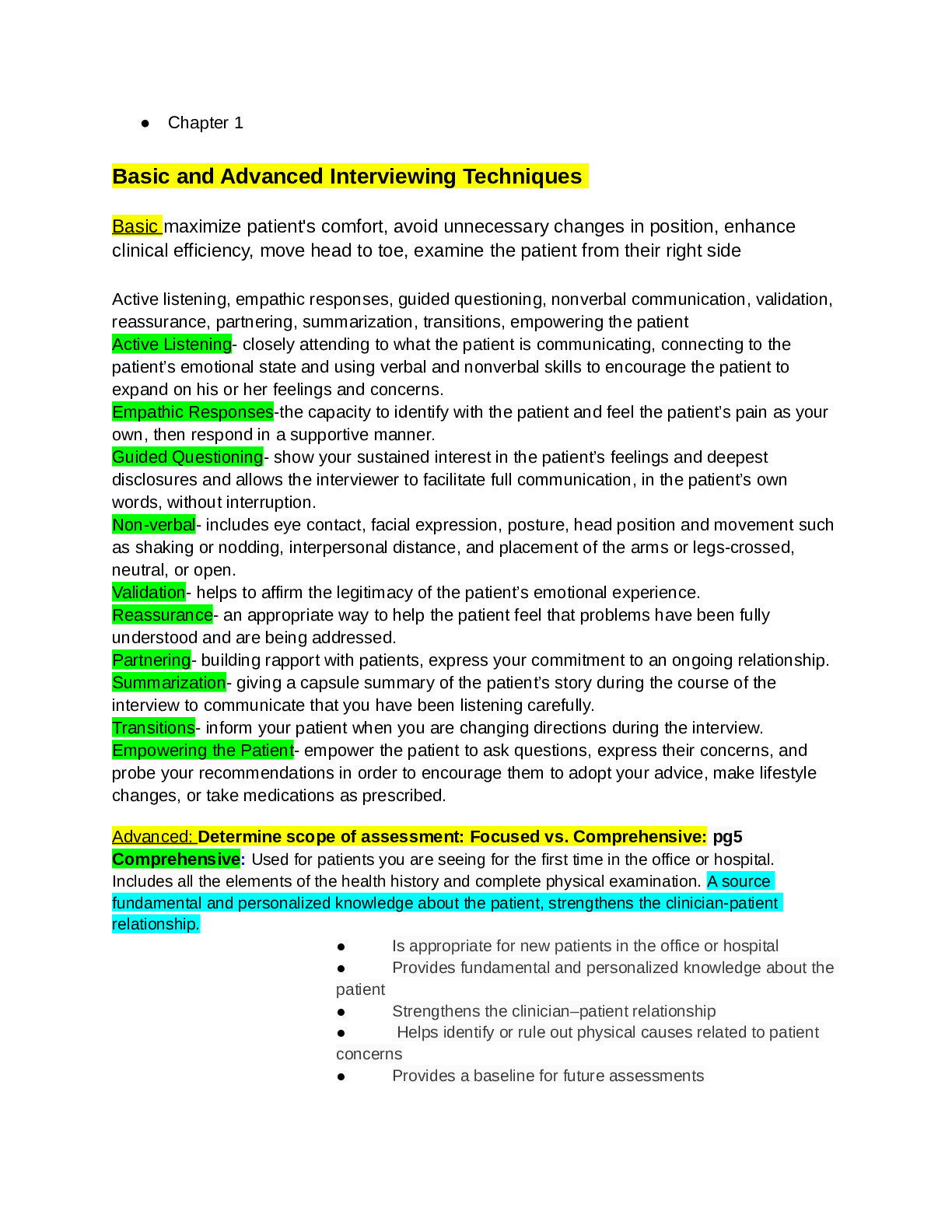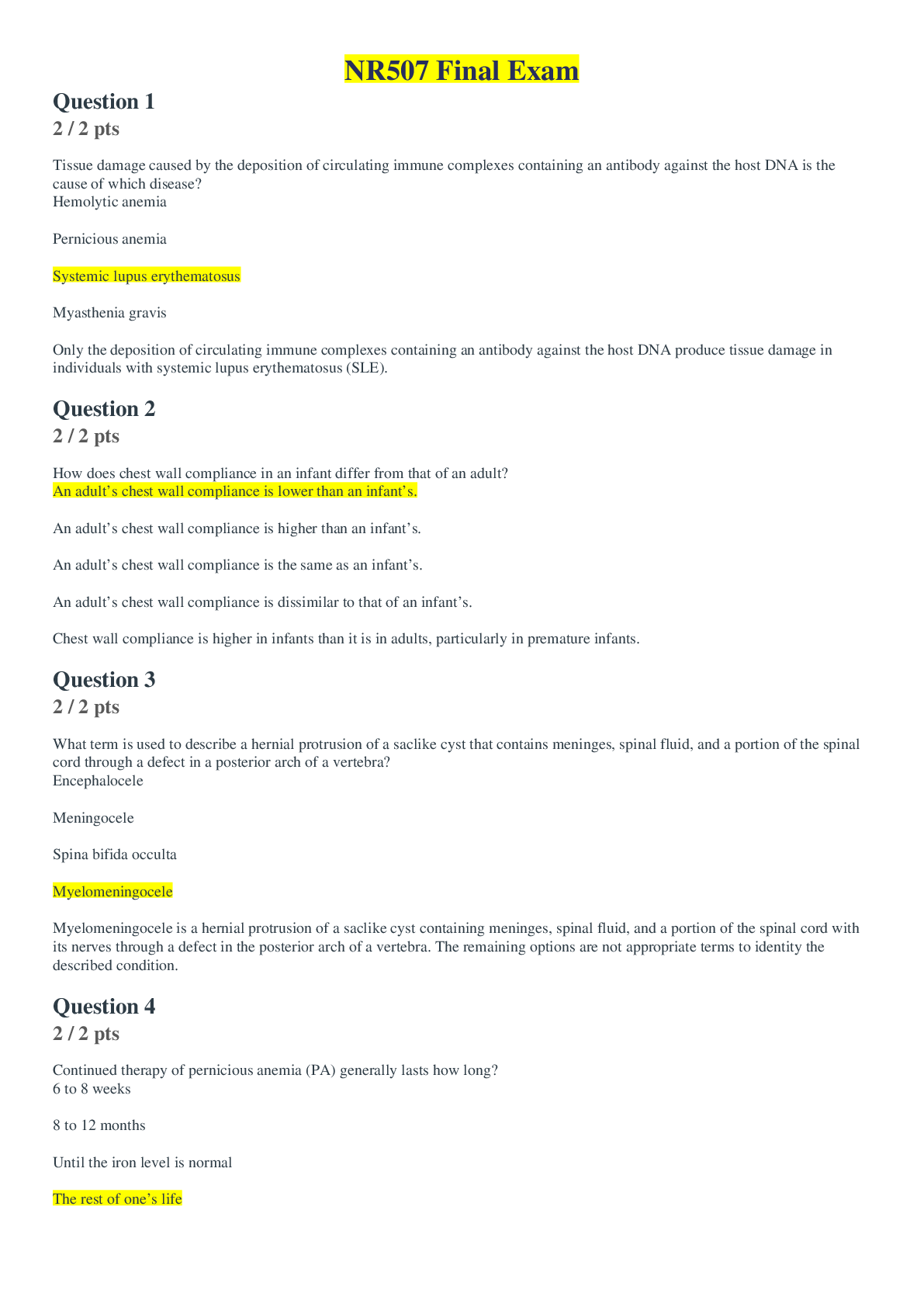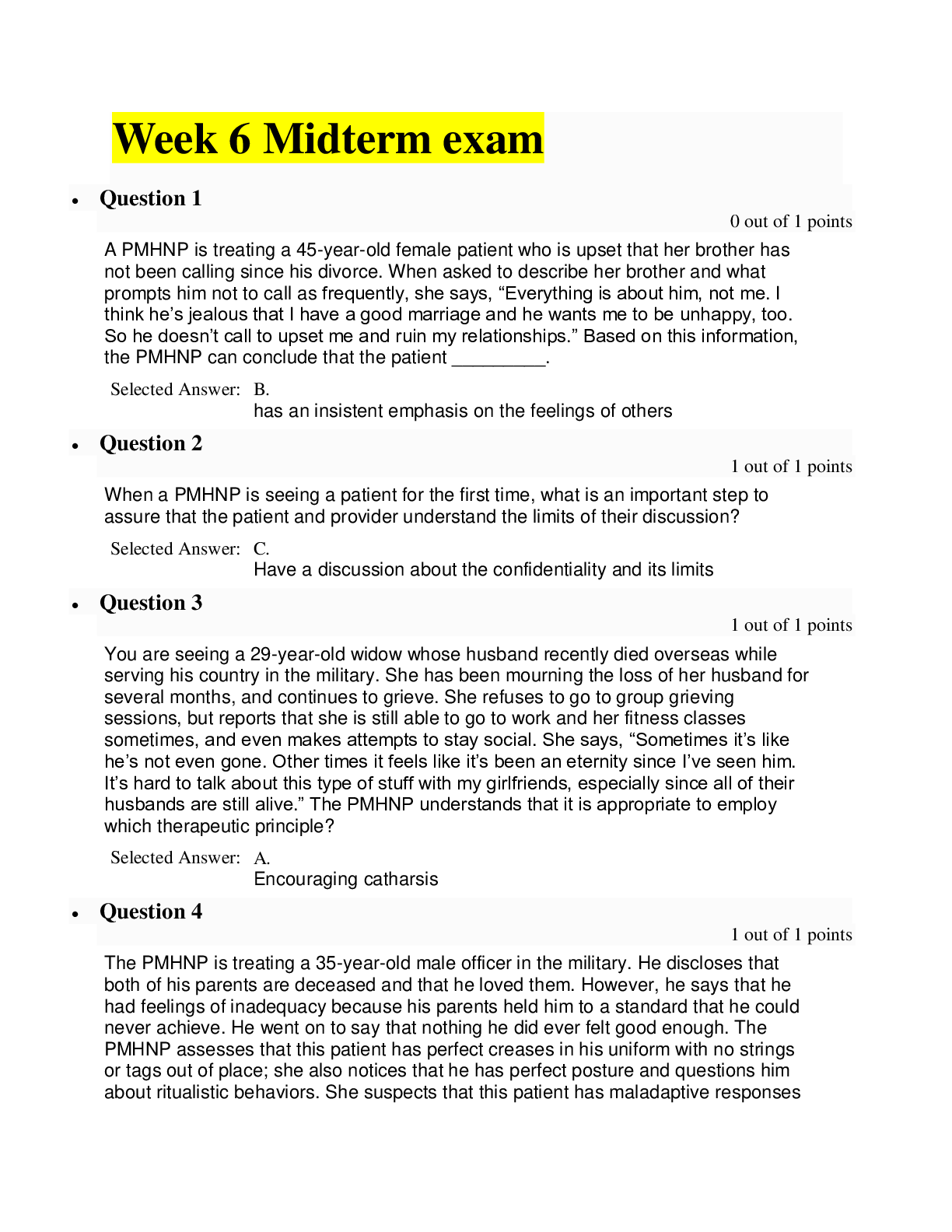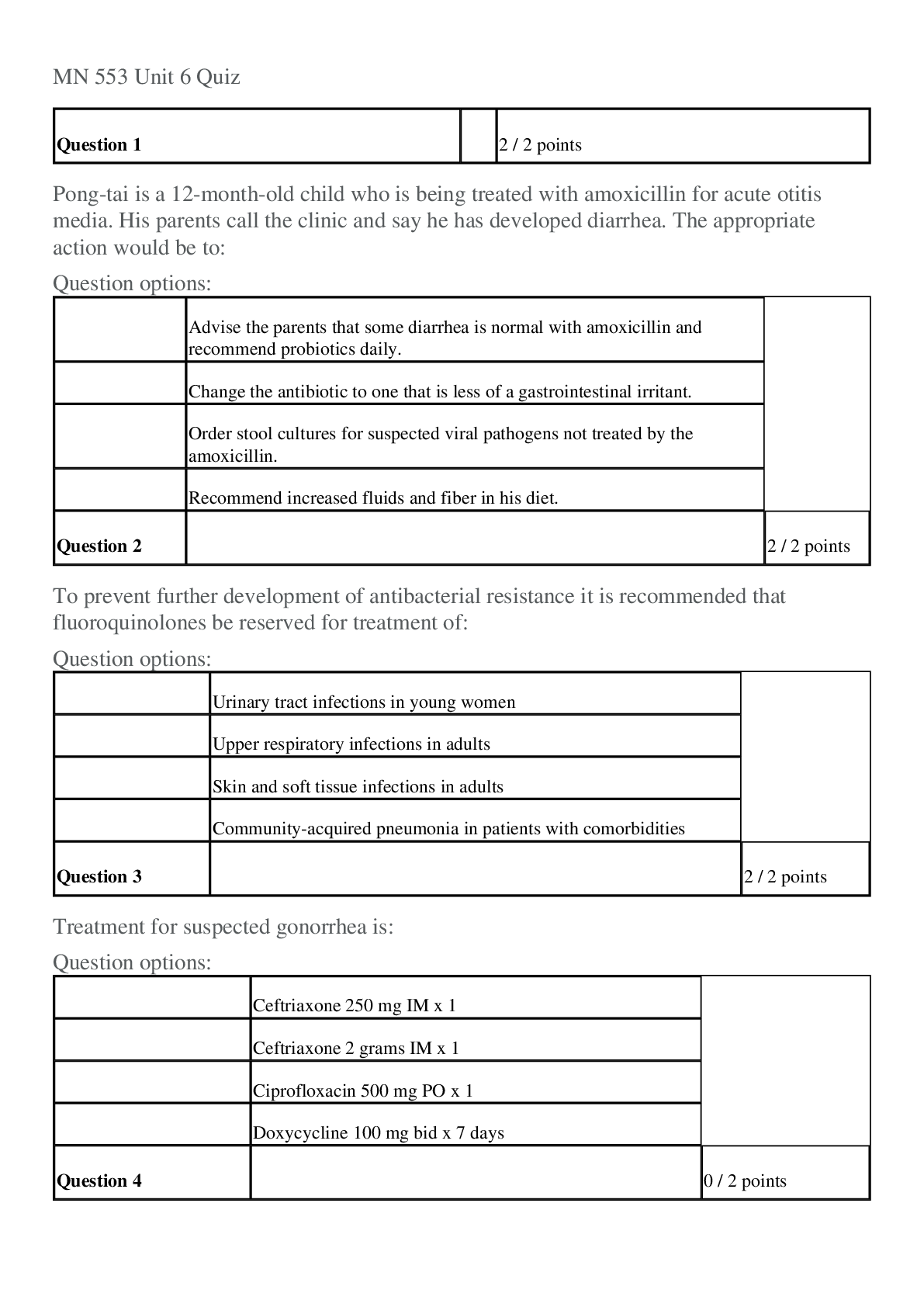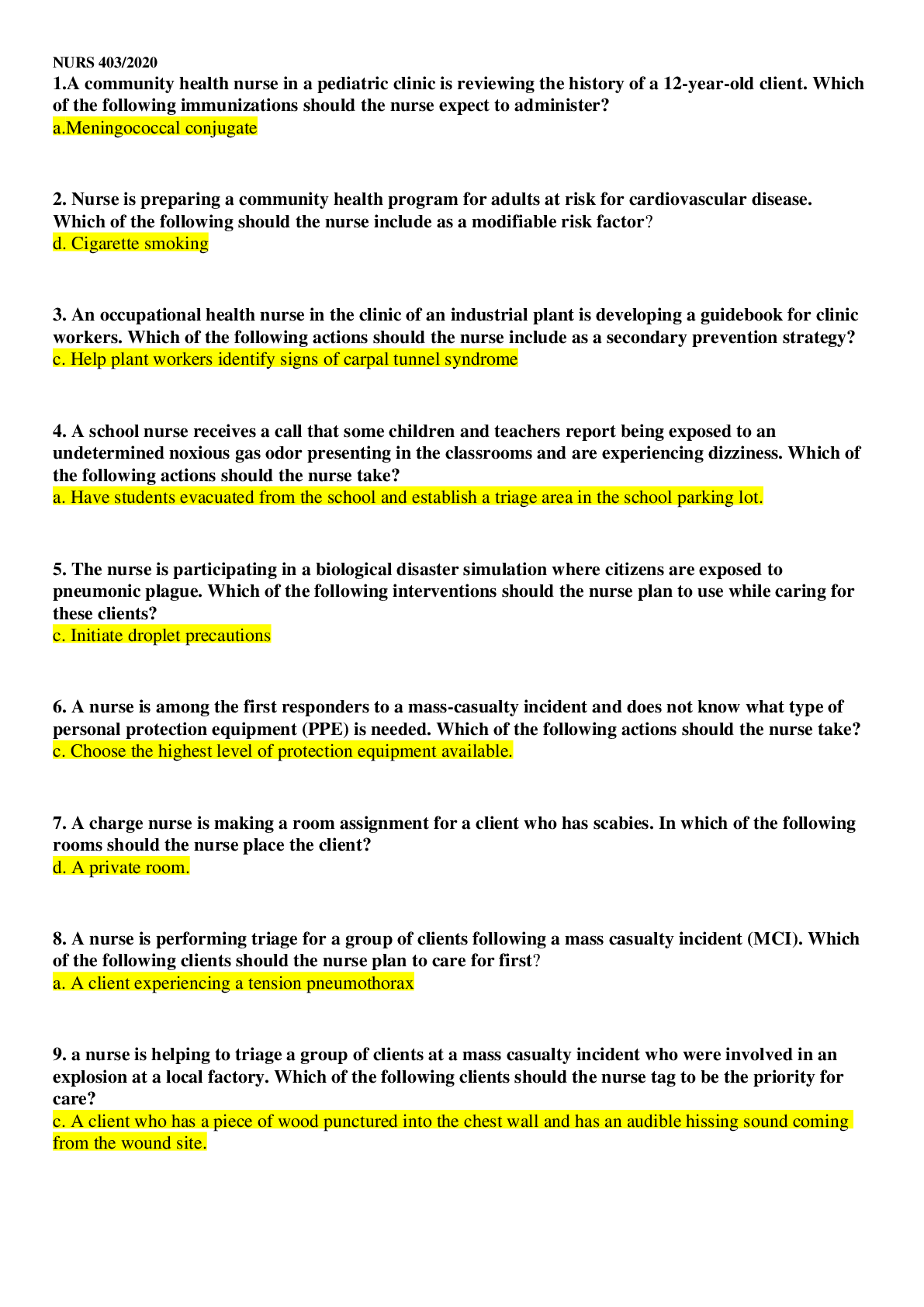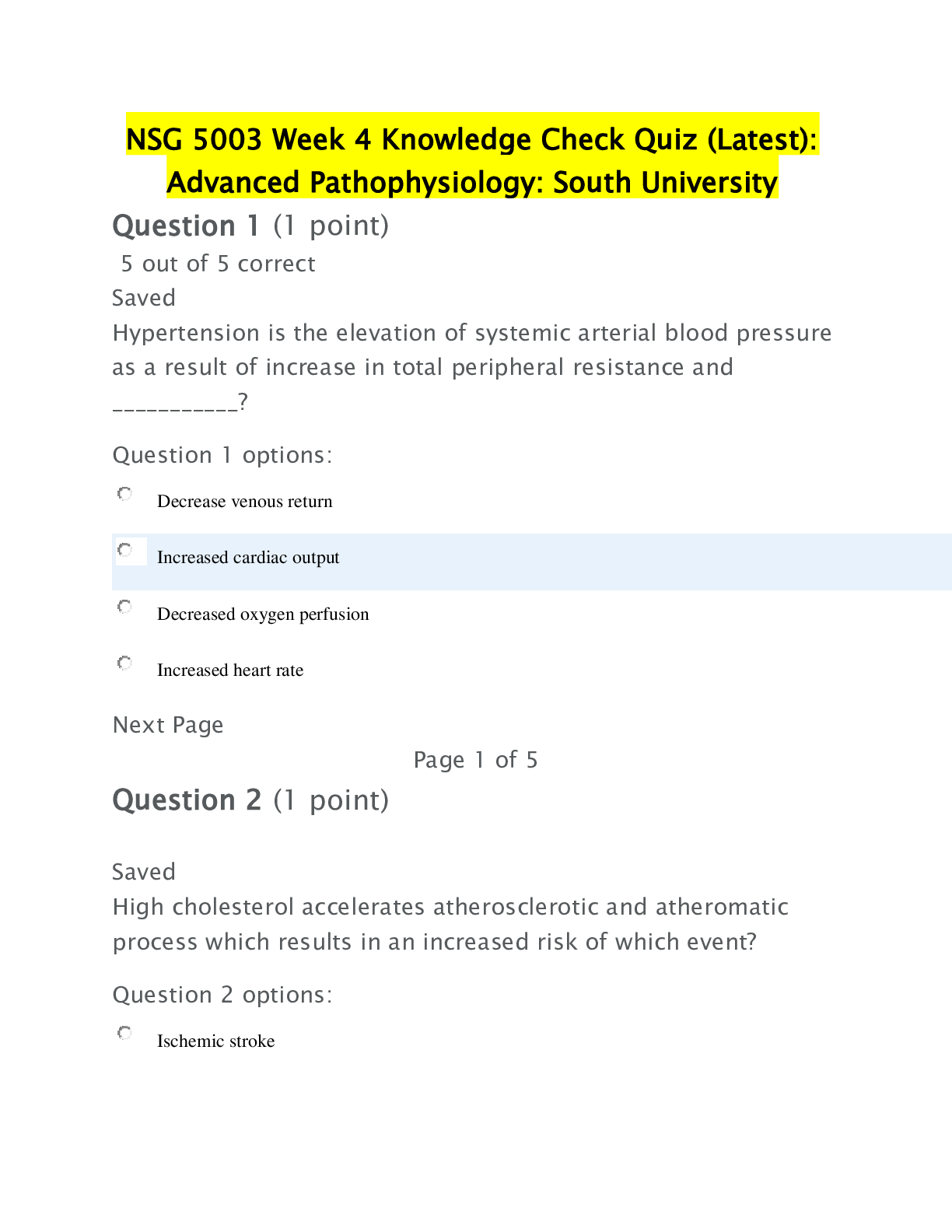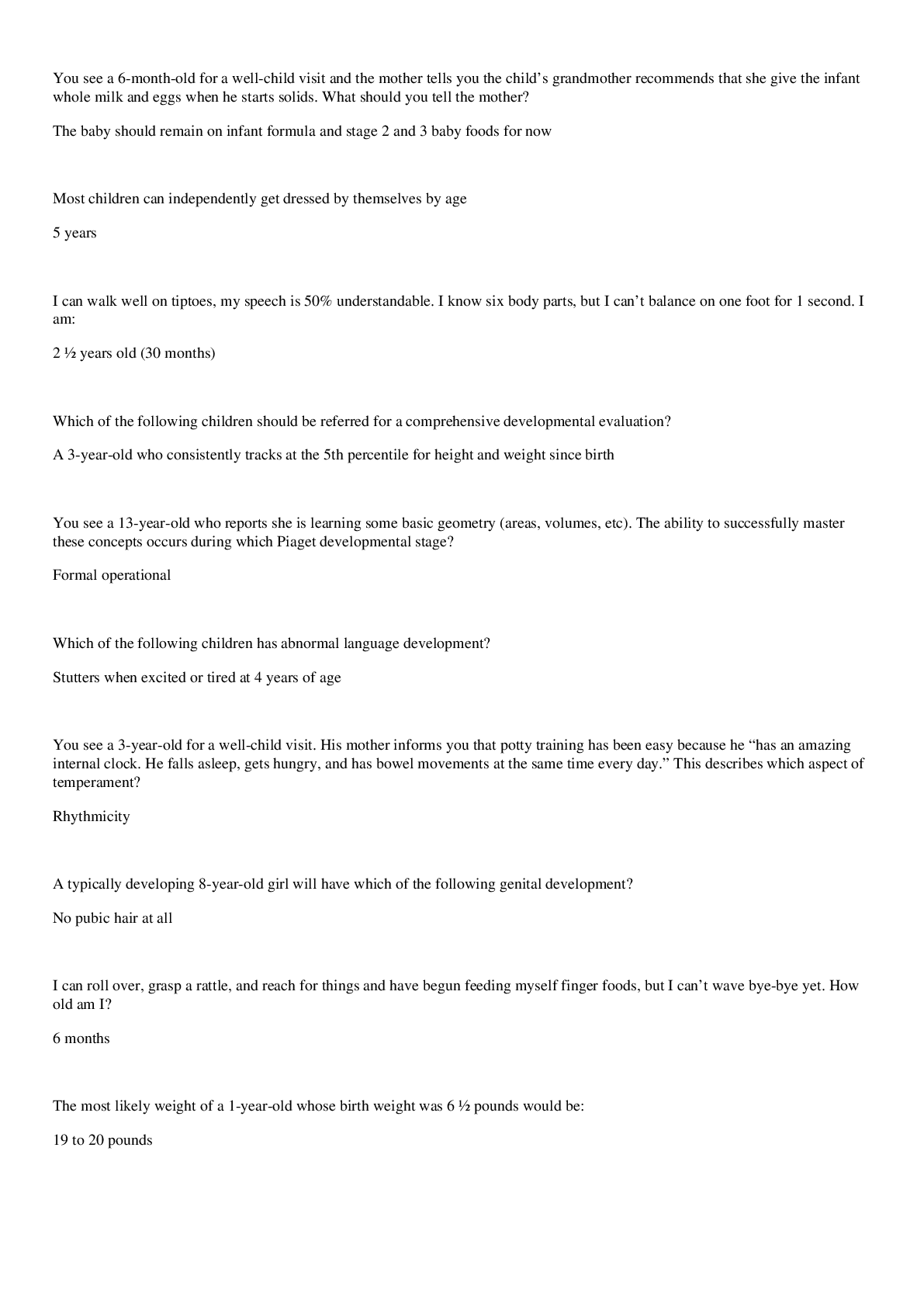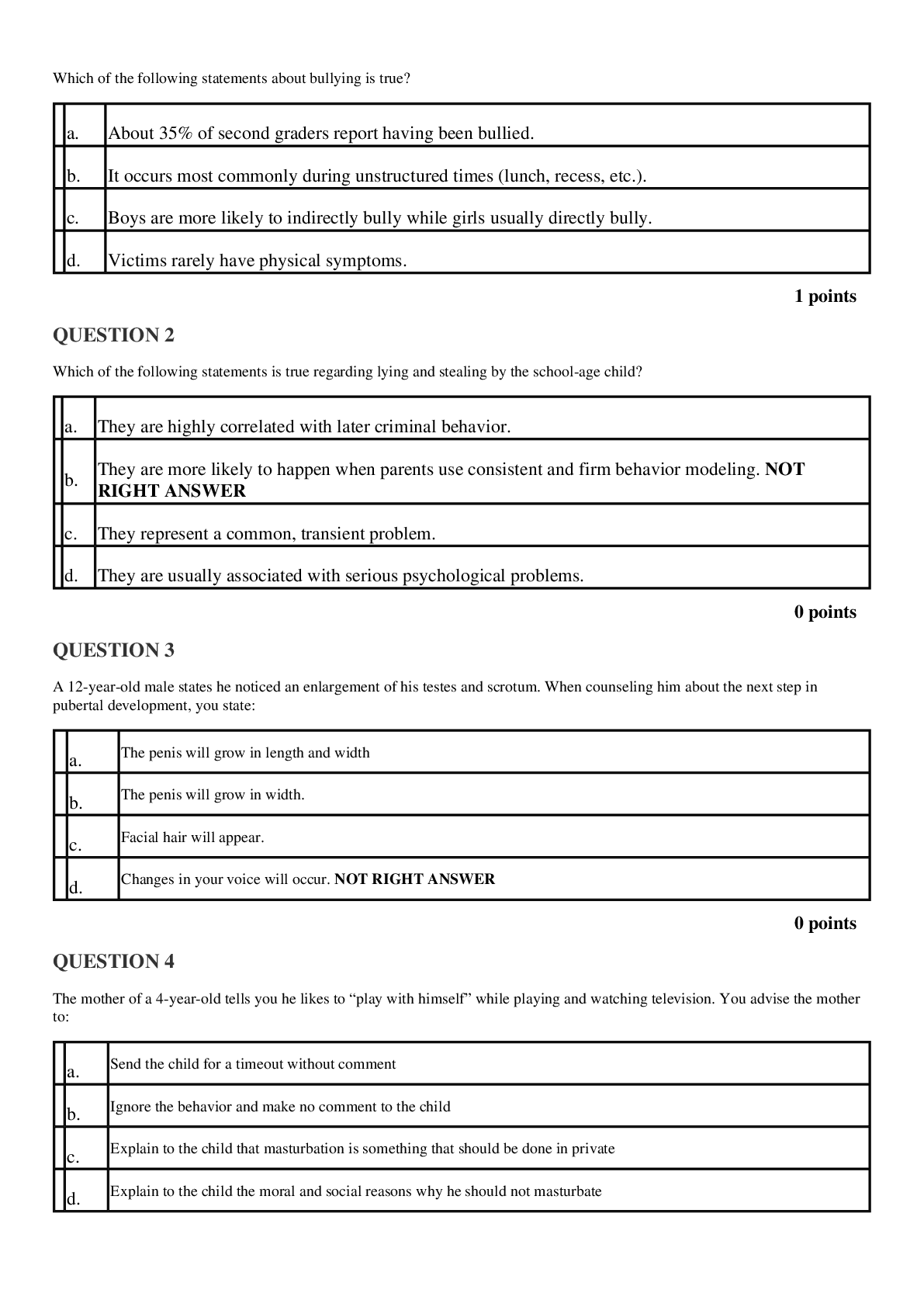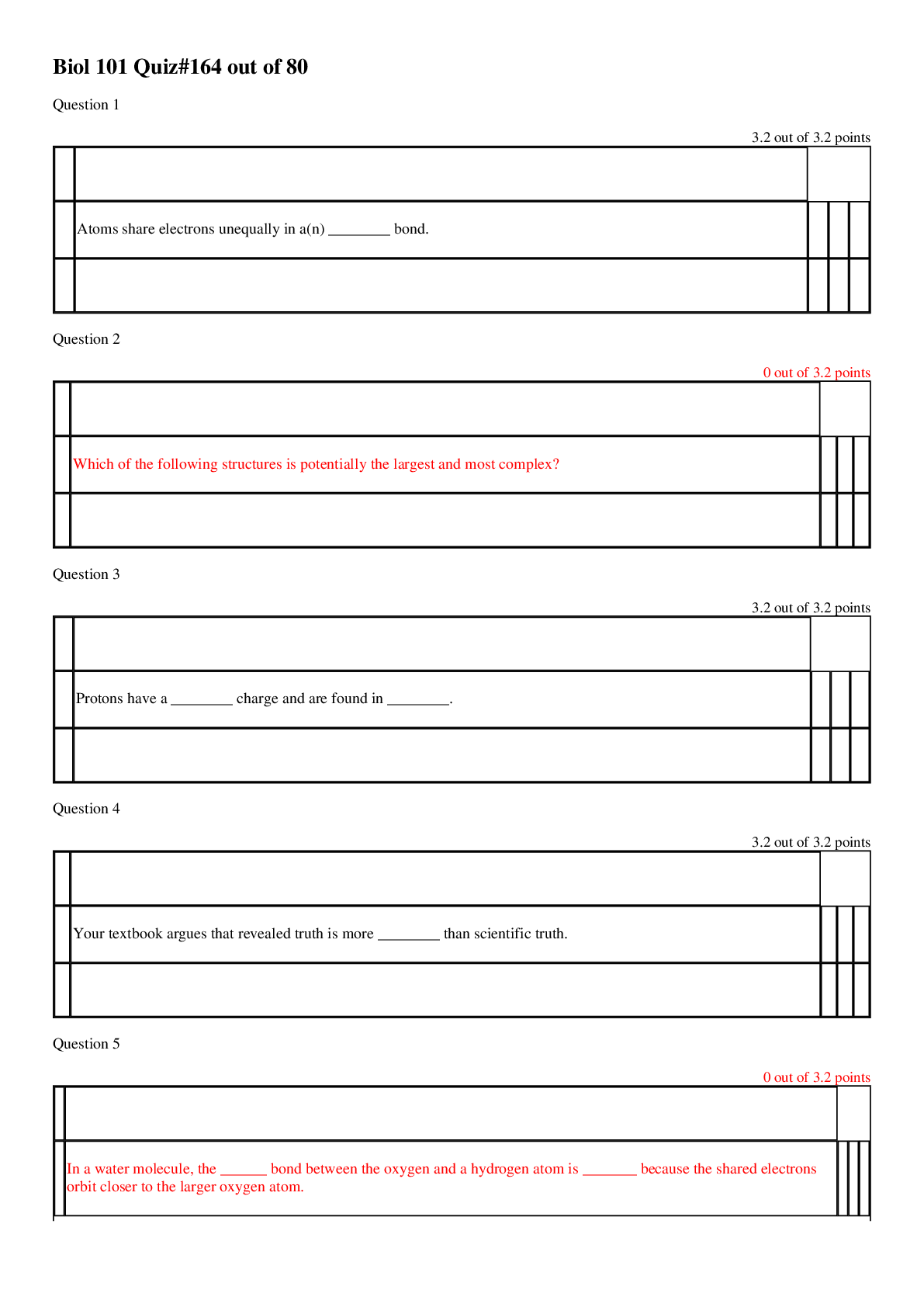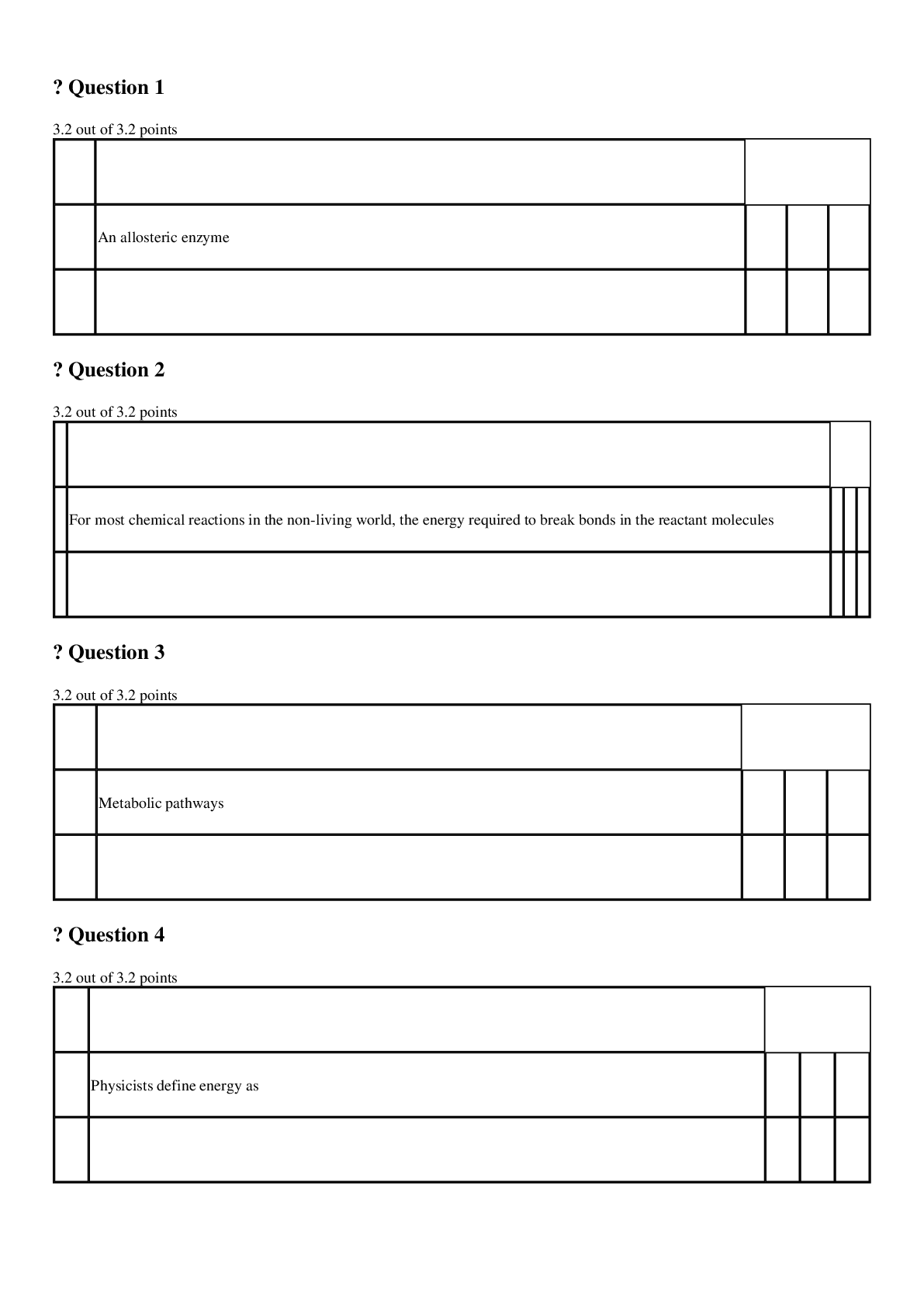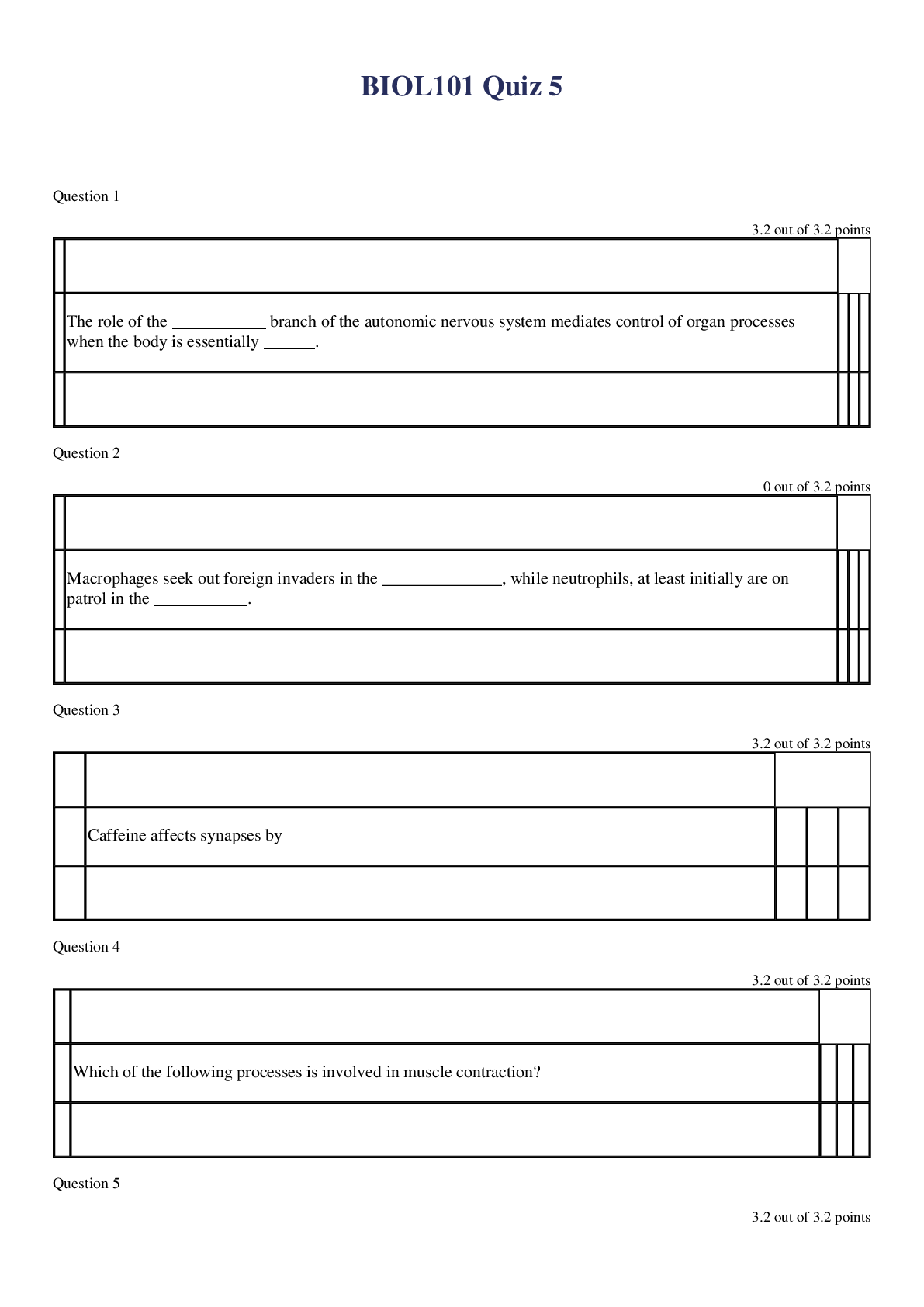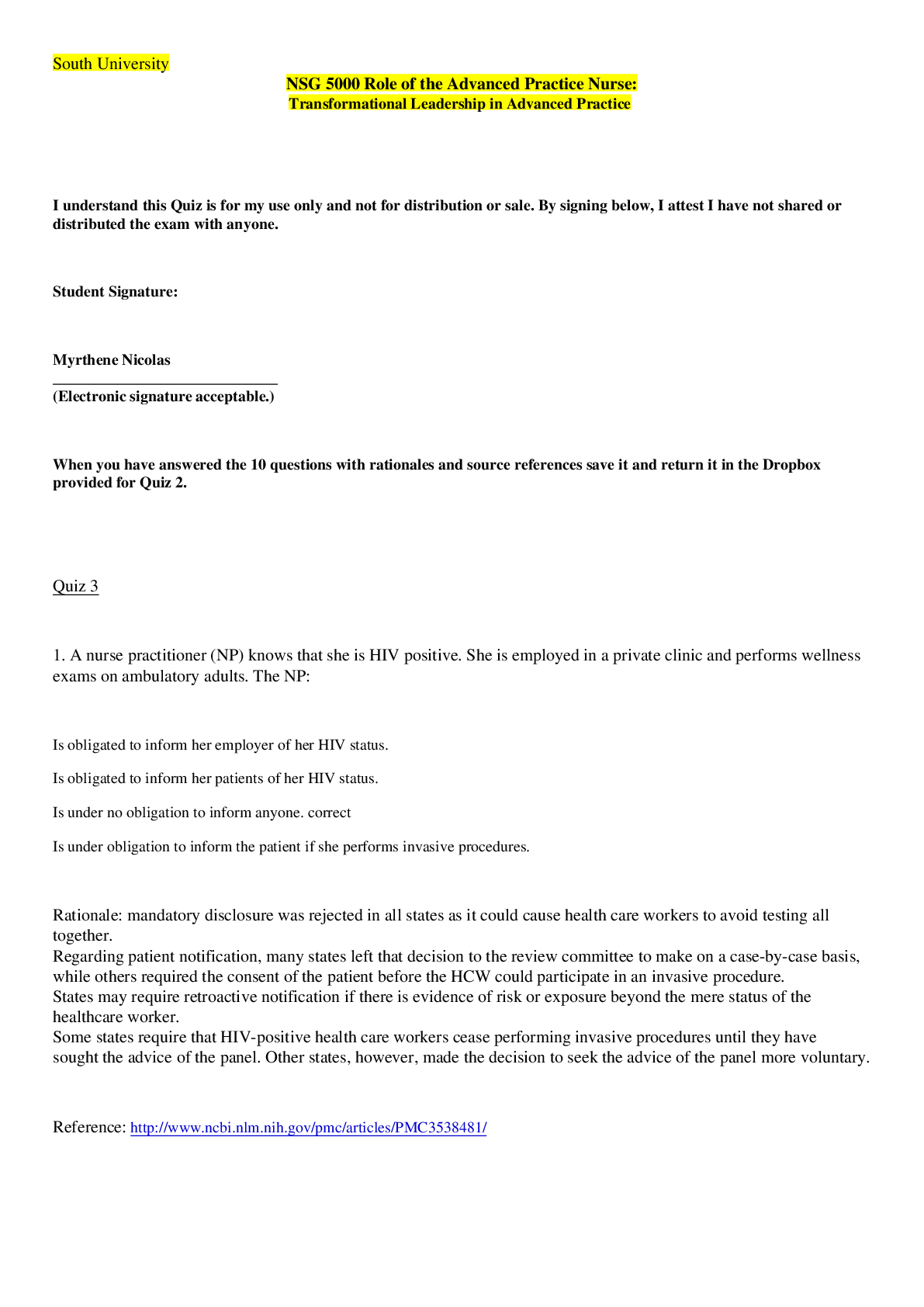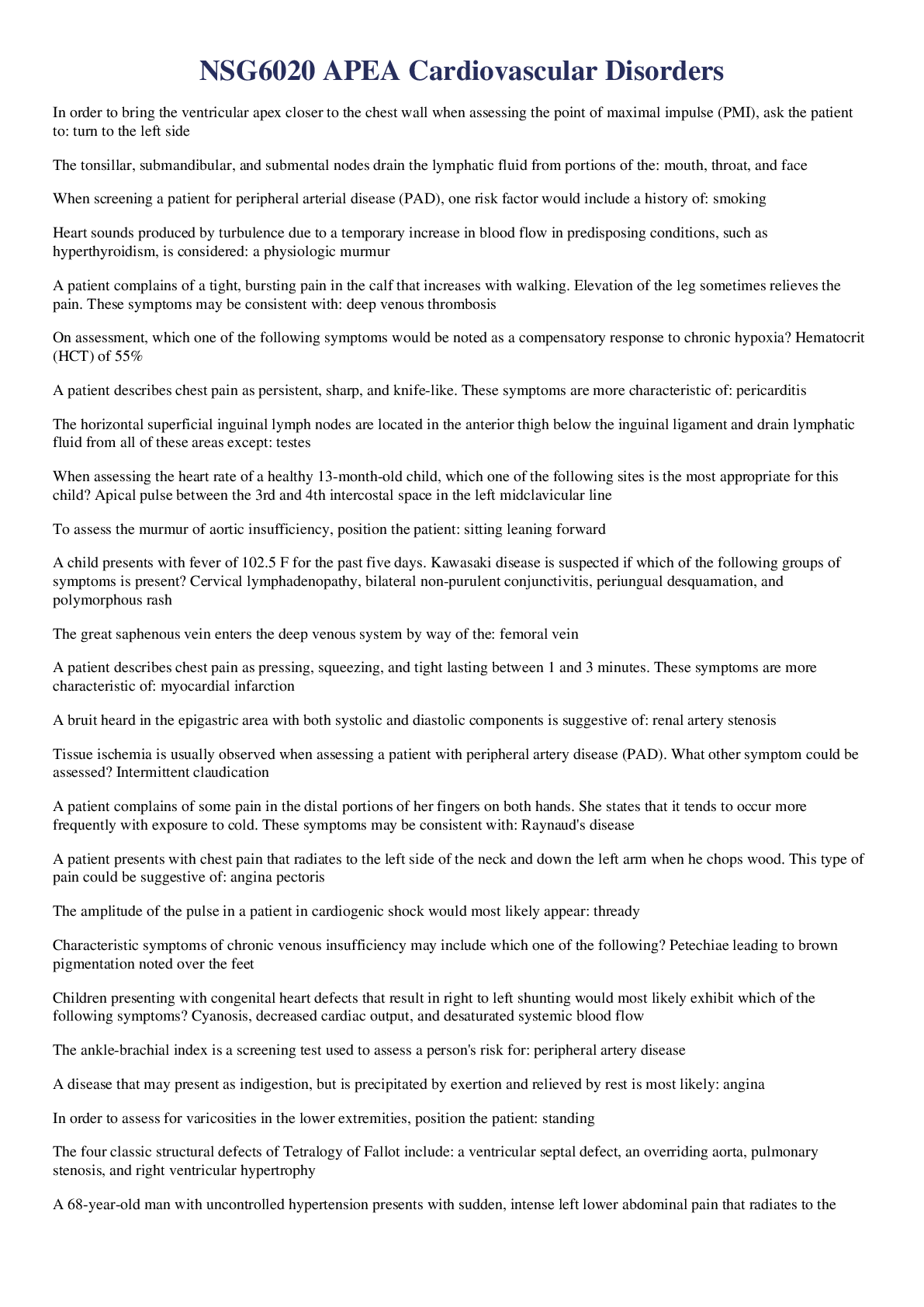*NURSING > EXAM > NSG5003 Week 9 Knowledge Check Quiz / NSG 5003 Week 9 Knowledge Check Quiz (Latest, 2020): South Uni (All)
NSG5003 Week 9 Knowledge Check Quiz / NSG 5003 Week 9 Knowledge Check Quiz (Latest, 2020): South University ( Verified Answers , Download to Score A)
Document Content and Description Below
NSG5003 Week 9 Knowledge Check Quiz / NSG 5003 Week 9 Knowledge Check Quiz: Advanced Pathophysiology: South University South University NSG5003 Week 9 Knowledge Check Quiz: Advanced Pathophysiology Qu... estion 1 (1 point) Cheyne–Stokes respirations are described as a: Question 1 options: Sustained, deep, rapid but regular pattern of breathing Crescendo-decrescendo pattern of breathing, followed by a period of apnea Prolonged inspiratory period, gradually followed by a short expiratory period Completely irregular breathing pattern with random, shallow, deep breaths and irregular pauses Question 2 (1 point) Vomiting is associated with CNS injuries that compress which of the brain’s anatomic locations? Question 2 options: Vestibular nuclei in the lower brainstem Floor of the third ventricle Any area in the midbrain Diencephalon Question 3 (1 point) Which person is at the greatest risk of developing delirium? Question 3 options: An individual with diabetes, celebrating his or her seventieth birthday A depressed Hispanic woman An individual on the second day after hip replacement A patient in for uncontrolled hyper tension Question 4 (1 point) A sudden, explosive, disorderly discharge of cerebral neurons is termed: Question 4 options: Reflex Seizure Epilepsy Convulsion Question 5 (1 point) A complex partial seizure is described as: Question 5 options: Alternating of tonic and clonic movements Impairment of both consciousness and the ability to react to exogenous stimuli Focal motor movement without loss of consciousness One seizure followed by another in less than one minute Question 6 (1 point) Status epilepticus is considered a medical emergency because of the: Question 6 options: Loss of consciousness Development of cerebral hypoxia Possibility of a head injury during seizures Decrease in brain metabolism Question 7 (1 point) Tremors at rest, rigidity, akinesia, and postural abnormalities are a result of the atrophy of neurons in the: Question 7 options: Caudate lobe, which that produces serotonin Putamen, which produces gamma-aminobutyric acid (GABA) Substantia nigra, which produces dopamine Hypothalamus, which produces acetylcholine Question 8 (1 point) Diffuse axonal injuries (DAIs) of the brain often result in: Question 8 options: Reduced levels of consciousness Mild but permanent dysfunction Fine motor tremors Visual disturbances Question 9 (1 point) Which group is most at risk of spinal cord injury from minor trauma? Question 9 options: Children Adolescents Adults Older adults Question 10 (1 point) What indicates that spinal shock is terminating? Question 10 options: Voluntary movement below the level of injury Reflex emptying of the bladder Paresthesia below the level of injury Decreased deep tendon reflexes and flaccid paralysis Question 11 (1 point) Which term is used to describe a complication that can result from a spinal cord injury above T6 that is producing paroxysmal hypertension, as well as piloerection and sweating above the spinal cord lesion? Question 11 options: Craniosacral dysreflexia Parasympathetic dysreflexia Autonomic hyperreflexia Retrograde hyperreflexia Question 12 (1 point) Why does a person who has a spinal cord injury experience faulty control of sweating? Question 12 options: The hypothalamus is unable to regulate body heat as a result of damage to the sympathetic nervous system. The thalamus is unable to regulate body heat as a result of damage to the sympathetic nervous system. The hypothalamus is unable to regulate body heat as a result of damage to the parasympathetic nervous system. The thalamus is unable to regulate body heat as a result of damage to spinal nerve roots. Question 13 (1 point) Spinal cord injuries most likely occur in which region? Question 13 options: Cervical and thoracic Thoracic and lumbar Lumbar and sacral Cervical and thoracic-lumbar Question 14 (1 point) The most likely rationale for body temperature fluctuations after cervical spinal cord injury is that the person has: Question 14 options: Developed bilateral pneumonia or a urinary tract infection (UTI) Sustained sympathetic nervous system damage resulting in disturbed thermal control Sustained a head injury that damaged the hypothalamus’s ability to regulate temperature Developed septicemia from posttrauma infection Question 15 (1 point) Multiple sclerosis is best described as a(an): Question 15 options: CNS demyelination, possibly from an immunogenetic virus Inadequate supply of acetylcholine at the neurotransmitter junction as a result of an autoimmune disorder Depletion of dopamine in the CNS as a result of a virus Degenerative disorder of lower and upper motor neurons caused by viral-immune factors Question 16 (1 point) What is the most common opportunistic infection associated with acquired immunodeficiency syndrome (AIDS)? Question 16 options: Non-Hodgkin lymphoma Kaposi sarcoma Toxoplasmosis Cytomegalovirus Question 17 (1 point) It is true that Guillain–Barré syndrome (GBS): Question 17 options: Is preceded by a viral illness Involves a deficit in acetylcholine Results in asymmetric paralysis Is an outcome of human immunodeficiency virus (HIV) Question 18 (1 point) It is true that myasthenia gravis: Question 18 options: Is an acute autoimmune disease Affects the nerve roots May result in adrenergic crisis Causes muscle weakness Question 19 (1 point) In which disorder are acetylcholine receptor antibodies (immunoglobulin G [IgG] antibodies) produced against acetylcholine receptors? Question 19 options: Guillain-Barré syndrome (GBS) Multiple sclerosis Myasthenia gravis Parkinson disease Question 20 (1 point) Question 20 options: What data confer the link between bipolar disorders and schizophrenia? Individuals with bipolar disorder who exhibit psychotic behaviors have deficits in reelin expression linked to genetic loci located on chromosome 22. Individuals with schizophrenia who exhibit psychotic behaviors have deficits in serotonin linked to genetic loci located on chromosome 16. Individuals with bipolar disorder who exhibit psychotic behaviors have deficits in gamma-aminobutyric acid (GABA) linked to genetic loci located on chromosome 20. Individuals with schizophrenia who exhibit psychotic behaviors have deficits in reelin expression linked to genetic loci located on chromosome 18. [Show More]
Last updated: 1 year ago
Preview 1 out of 6 pages

Buy this document to get the full access instantly
Instant Download Access after purchase
Add to cartInstant download
We Accept:

Reviews( 0 )
$5.00
Document information
Connected school, study & course
About the document
Uploaded On
May 05, 2020
Number of pages
6
Written in
Additional information
This document has been written for:
Uploaded
May 05, 2020
Downloads
0
Views
44


